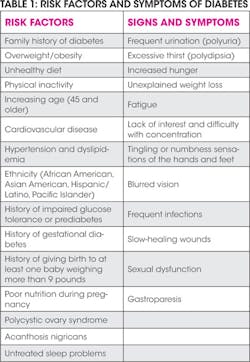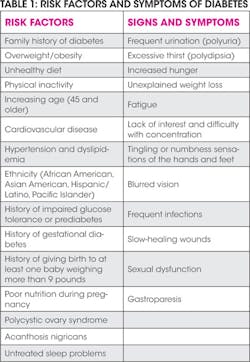Action Needed on Diabetes
Develop a plan for National Diabetes Month
BY JOANN R. GURENLIAN, RDH, PhD
November is National Diabetes Month and we need to plan ahead to implement interventions that will help all of us - patients and health care providers - tackle this epidemic. The 2014 National Diabetes Statistics Report1 was released in June and details the devastating burden of diabetes in the United States.
Worldwide, diabetes affects 382 million people. By 2030, diabetes is expected to become the seventh leading cause of death, with total deaths rising more than 50% over the next ten years.2 In the U.S., 29.1 million people have diabetes. This represents 9.3% of the population. Of this group, 21 million people have been diagnosed with the disease while another 8.1 million individuals are undiagnosed. Further, it is estimated that 86 million Americans aged 20 years or older have prediabetes.1 The alarming growth in diabetes and prediabetes is largely due to increases in weight and physical inactivity.2
As oral health professionals, it is important to consider the steps we can take to help identify undiagnosed diabetes in our patients and to offer support in preventing and controlling this devastating disease. First, as part of the assessment phase of the dental hygiene process of care, we can conduct a risk assessment on our patients. Table 1 identifies the risk factors associated with type 2 diabetes. We can point out to our patients that the more risk factors they have, the higher the risk of type 2 diabetes, and recommend that they be further evaluated by a primary care physician or nurse practitioner.
Another step in this process is to assess for signs and symptoms of diabetes. This is especially important for those patients not yet diagnosed with diabetes. Table 1 summarizes these signs. It is important to appreciate that symptoms of type 2 diabetes may be mild in those developing the disease, making it more difficult to detect.
Further, since chairside A1c tests are available, we can incorporate screening for diabetes in our practice settings. A1c (or glycated hemoglobin A1c) is a test that is widely used as a marker of chronic glycemia, revealing average blood glucose levels over a two- to three-month period of time. This test correlates well with both microvascular and macrovascular complications and is critical in the management of this disease.
For our patients who present with diabetes or prediabetes, it is important to remind them that diabetes can be controlled. We need to encourage our patients to make lifestyle changes, partake in regular physical activity, take prescribed medications, eat a balanced diet, reach and maintain a reasonable body weight, take vitamin D supplements, join a smoking cessation program if appropriate, and improve sleeping patterns. Our patients need to understand that early intervention with an interdisciplinary health care team that includes oral health professionals will help them achieve and maintain improved health.
We need to be mindful that patients presenting with cervical caries, periodontal disease, fungal infections, xerostomia, burning mouth syndrome, and abscesses may also be manifesting signs of diabetes. Coordinating oral findings with our assessments of risk factors and signs and symptoms of diabetes may be another way to identify undiagnosed diabetes in our patients.
The recommendations noted above are a starting point for us in providing comprehensive care to our patients. If you are wondering how to initiate diabetes assessments in your practice, consider using November, National Diabetes Month, as the opportunity to add these assessments into your practice regimen. Explain to your patients that diabetes has reached epidemic proportions in our country and that millions of individuals do not know they have the disease. Ask them to complete a risk assessment and to identify any signs and symptoms they might have, and use that as the basis of a conversation that educates them about diabetes. It is going to take the actions of all health care providers to change the picture of diabetes in our country. Dental hygienists can make a difference in supporting the efforts to raise awareness and to promote prevention and control of diabetes. Let's get started!
References
1. International Diabetes Federation. Diabetes: facts and figures. Available at: idf.org/worlddiabetesday/toolkit/gp/facts-figures. Accessed April 23, 2014.
2. Centers for Disease Control and Prevention. National Diabetes Statistics Report: Estimates of Diabetes and Its Burden in the United States, 2014. Atlanta, GA: U.S. Department of Health and Human Services; 2014.
3. National Diabetes Information Clearinghouse. Am I At Risk for Type 2 Diabetes? Taking Steps to Lower Your Risk of Getting Diabetes. Available at: diabetes.niddk.nih.gov/dm/pubs/riskfortype2. Accessed April 23, 2014.
4. International Diabetes Federation. Diabetes Risk Factors. Available at: idf.rg/worlddiabetesday/toolkit/gp/riskfactors. Accessed April 23, 2014.
5. International Diabetes Federation. Diabetes Warning Signs. Available at: idf.org/worlddiabetesday/toolkit/gp/warning signs. Accessed April 23, 2014.
JOANN R. GURENLIAN, RDH, PhD, is president of Gurenlian & Associates, and provides consulting services and continuing education programs to health-care providers. She is a professor and dental hygiene graduate program director at Idaho State University, and president of the International Federation of Dental Hygienists.
Past RDH Issues

